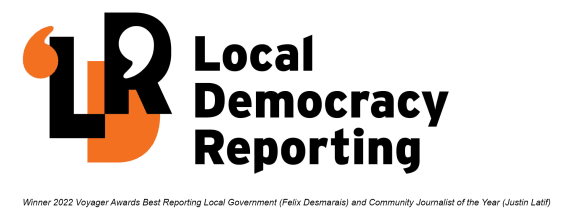
West Coast Regional Council staff and elected officials viewing the hole in the northern stop bank on 7 March - just 48 hours later a moderately flooded Wanganui River broke through and flooded two farms. Photo: Local Democracy Reporting/ Greymouth Star - Brendon McMahon
Stopbanks have "strangled" South Westland's Wanganui River so much in the past 60 years the riverbed is now filling with gravel at twice the natural rate, an engineer says.
Land River Sea Consulting river engineer Matt Gardner studied the river over the past decade for the West Coast Regional Council and recently briefed Wanganui River farmers on the problem, and the challenge from increasingly intense storms.
He reinforced his point by noting that the stopbanks on the true right (north bank) now sit in the middle of where the river flowed in 1964.

Gardner told the stunned gathering that the site of the most recent flooding of north bank farmland, about 7km below the state highway bridge, had previously been identified as a weak point.
And the flood plain where the river broke through last month was, until 40 years ago, the normal riverbed.
He said the rate of riverbed aggradation (deposits) was startling.
"At the bottom, 7km downstream of the bridge, we can now see the river is perched above the flood plain."
Gardner said two-dimensional modelling and LIDAR data now gave more accurate information for the whole riverbed.
"We wanted to understand better the breach situation and look at areas of potential erosion and aggradation."
Original wide braided river system became used for farming
The first 400m stopbank on the true left (south bank) was built in 1913 adjoining the original Wanganui River bridge.
Until 1958 little further protection work was done on the river. But from the mid-1960s to mid-1970s big groynes, training walls and 8km of stopbank were built, right down the true left.
Stopbanks on the other side started appearing in the mid-1970s and into the late 1980s.
A 1948 aerial view superimposed on aerial images through the years, graphically showed the growth of stopbanks across the original bed.
"We can see in 1948 we had a very wide, natural braided river system," Gardner said.
The most recent flood breaches in February and March were basically in the middle of the 1964 riverbed, he said.
Current pasture land in that area was, in 1981, an overflow area that naturally pushed toward Lake Ianthe.
"You can see the natural contours of the river is to flow into the lake ...The current breach was the river flowing through an area it was in 1984."
By 1984 the aerial evidence was that this area was being farmed.

Flooding from the Wanganui River swamps a farm race on the farm of Bernard Walkington in March after the river broke through a protection bank hole unrepaired by the West Coast Regional Council following an earlier moderate flood in early February. Photo: Supplied/Bernard Walkington
"We can see we've progressively reclaimed riverbed and converted it into pasture - we've basically halved the width of the river."
The river was now "squeezing" its flow through half of its former bed, and "it basically aggrades at two times the speed".
The Wanganui was behaving like a typical braided river, moving huge volumes of sediment.
But it had now reached a point where use of stopbanks was critically compromised, and was now much worse at lower flood points, with an increased risk of flood flows 'overtopping' and causing the rockwalls to fail.
"We've built a protection network that's impacted on the behaviour of the river. This has exacerbated our aggradation."
It also increased the gradient of the bed and exacerbated the river moving across the bed. It could end up increasing the velocities against the stopbanks.
Increasing storms, climate changes
"You may have noticed patterns over time, but this part of the West Coast is quite prone to climate."
Complex factors included the Interdecadal Pacific Oscillation (IPO) which was influencing climate variability over the Pacific Basin.
Gardner said the West Coast and other areas such as Tairāwhiti in the North Island were currently into the long IPO period, characterised by more frequent and violent storms.
The true left bank of the Wanganui River scheme had been built in "a quiet period of that IPO".
It was now producing more frequent storms, which had coincided with a warming Tasman Sea in the past few years at two times the rate of any other ocean.
"We've got to be realistic that the climate is changing. We can expect to have more intense storms coming in."
Local Democracy Reporting is Public Interest Journalism funded through NZ On Air

![Supplied/West Coast Regional Council
[Wanganui stopbank damage] A view upriver towards the State Highway 6 bridge following the August storm which took out chunks of the northern bank stop bank, left.](https://media.rnztools.nz/rnz/image/upload/s--nW-6LAif--/ar_16:10,c_fill,f_auto,g_auto,q_auto,w_288/v1676942749/4LD8K16_IMG_0434_scaled_jpg?_a=BACCd2AD)




